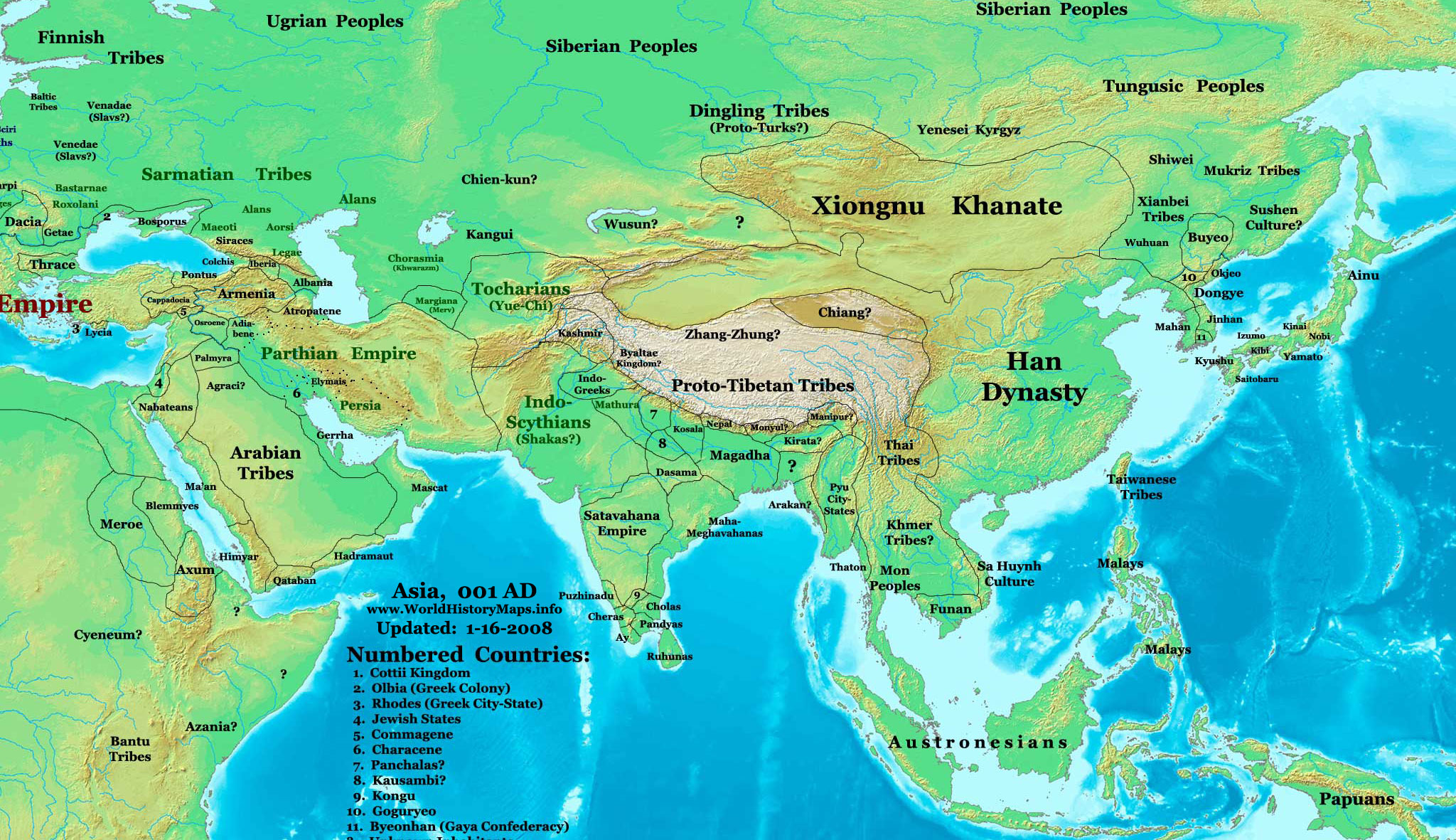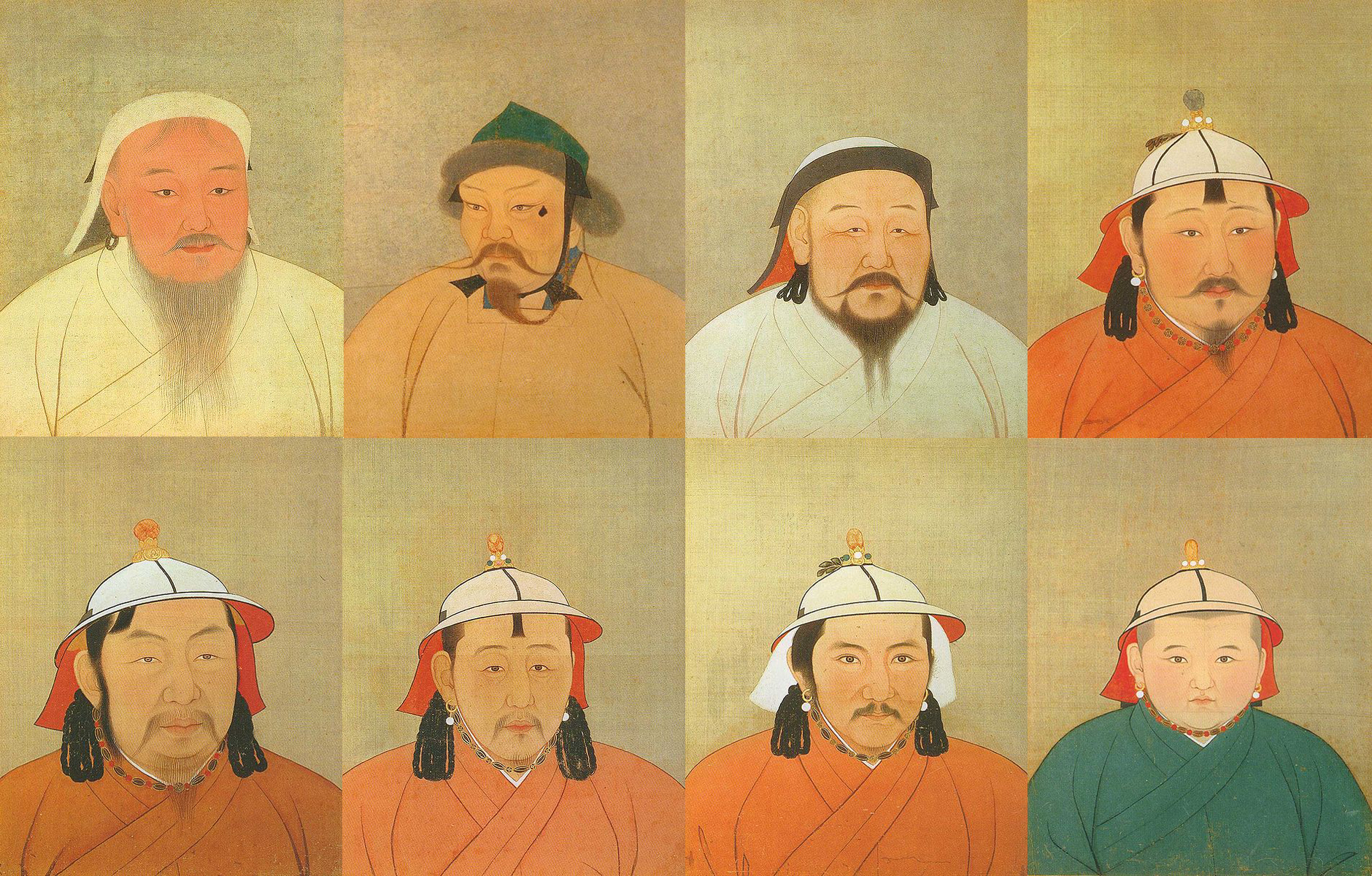|
Rouran
The Rouran Khaganate ( Chinese: zh, c=, p=Róurán, label=no), also known as Ruanruan or Juan-juan ( zh, c=, p=Ruǎnruǎn, label=no) (or variously ''Jou-jan'', ''Ruruan'', ''Ju-juan'', ''Ruru'', ''Ruirui'', ''Rouru'', ''Rouruan'' or ''Tantan''), was a tribal confederation and later state founded by a people of Proto-Mongolic Donghu origin. The Rouran supreme rulers used the title of , a popular title borrowed from the Xianbei. The Rouran Khaganate lasted from the late 4th century until the middle 6th century with territories that covered all of modern-day Mongolia and Inner Mongolia, as well as parts of Manchuria in Northeast China, Eastern Siberia, Xinjiang, and Kazakhstan. The Hephthalites were vassals of the Rouran Khaganate until the beginning of the 5th century, with the royal house of Rourans intermarrying with the royal houses of the Hephthalites. The Rouran Khaganate ended when they were defeated by a Göktürk rebellion at the peak of their power, which subseque ... [...More Info...] [...Related Items...] OR: [Wikipedia] [Google] [Baidu] |
Mugulü
Mugulü ( zh, c=木骨閭, p=Mùgǔlǘ) was a legendary warrior and chieftain in the Mongolian Plateau during the period when it was under the rule of tribes and peoples originating from the fragmentation of the failed and crumbling Xianbei confederation. The term "Mongol" is a likely derivation from his name. Biography Mugulü was likely born before AD 277, at the end of Tuoba Liwei's reign.Weishvol. 103始神元之末,掠騎有得一奴 tr. "In the beginning of the end of the Shenyuan, a uobaraider cavalryman acquired a slave" Little is known about his childhood. His date and place of birth, and the names of his parents or those of his consorts, are not disclosed in Book of Wei. He served in the Xianbei army under the leadership of the Tuoba tribal chief, Tuoba Yilu (295–316) of Dai. Possibly a legendary figure, he was a fugitive slave according to Chinese sources, however one researcher thinks that this is questionable and assumes that Chinese authors frequently ... [...More Info...] [...Related Items...] OR: [Wikipedia] [Google] [Baidu] |
Mumocheng
Mumocheng was the capital of the Rouran Khaganate. Its location is disputed, and no traces of it have been found. The capital of the Rouran Khaganate likely changed over time. While the Rouran were nomads, a capital city served, for one thing, as a place where all the khaganate's chieftains could convene to discuss very important matters regarding the steppe. It is plausible that Mumocheng was located in a place with more favorable climatic and geographic conditions than the average location in the territory of the Rouran Khaganate. The Chinese chroniclers described in this way the harsh conditions in which the Rouran lived: in their countries there are dismal mountains on which snow accumulates at the height of summer and the plains stretch for several thousand ''li'', their ends hidden from view no matter how the eyesight strains. There is no green grass in the steppe, the climate is severe, horses and cattle chew dry grass and lick snow, but they are fat and sound by nature Or ... [...More Info...] [...Related Items...] OR: [Wikipedia] [Google] [Baidu] |
Proto-Mongols
The proto-Mongols emerged from an area that had been inhabited by humans as far back as 45,000 years ago during the Upper Paleolithic. The people there went through the Bronze Age, Bronze and Iron Ages, forming tribal alliances, peopling, and coming into conflict with early polities in the Zhongyuan, Central Plain. The proto-Mongols formed various tribal kingdoms who fought against one other for supremacy, such as the Rouran Khaganate (330–555) until it was defeated by the Göktürks, who founded the First Turkic Khaganate (552–744), which in turn was subdued by the growing strength of the Tang dynasty. The destruction of the Uyghur Khaganate (744–848) by the Yenisei Kyrgyz resulted in the end of Turkic dominance on the Mongolian Plateau. The para-Mongol Khitan people founded also referred to by Chineses sources as Liao dynasty (916–1125) and ruled Mongolia and portions of the eastern coast of Siberia now known as the Russian Far East, northern Korea, and North China. Ove ... [...More Info...] [...Related Items...] OR: [Wikipedia] [Google] [Baidu] |
Rouran Language
Rouran (), also called Ruanruan, Ruan-ruan or Juan-juan (), is an unclassified extinct language of Mongolia and Inner Mongolia, spoken in the Rouran Khaganate from the 4th to the 6th centuries AD, considered a likely early precursor to Mongolic. Peter A. Boodberg claimed in 1935 that the Rouran language was Mongolic by analysing Chinese transcriptions of Rouran names. Atwood (2013) notes that Rourans calqued the Sogdian word ''pūr'' "son" into their language as *''kobun'' (Chinese transliteration: 去汾 MC *''kʰɨʌH-bɨun'' > Mandarin ''qùfén''); which, according to Atwood, is cognate with Middle Mongol ''kö'ün'' "son". Alexander Vovin noted that Old Turkic had borrowed some words from an unknown language not part of the Altaic sprachbund that might have been Rouran, arguing that if so, the language would be possibly a language isolate, though evidence was scant. In 2019, with the emergence of new evidence through the analysis of the '' Brāhmī Bugut'' and '' Khüis To ... [...More Info...] [...Related Items...] OR: [Wikipedia] [Google] [Baidu] |
Hephthalites
The Hephthalites (), sometimes called the White Huns (also known as the White Hunas, in Iranian languages, Iranian as the ''Spet Xyon'' and in Sanskrit and Prakrit as the ''Sveta-huna''), were a people who lived in Central Asia during the 5th to 8th centuries CE, part of the larger group of Eastern Iranian Huns. They formed an empire, the Imperial Hephthalites, and were militarily important from 450 CE, when they defeated the Kidarites, to 560 CE, when combined forces from the First Turkic Khaganate and the Sasanian Empire defeated them. After 560 CE, they established "principalities" in the area of Tokharistan, under the suzerainty of the Western Turks (in the areas north of the Amu Daria, Oxus) and of the Sasanian Empire (in the areas south of the Amu Daria, Oxus), before the Tokhara Yabghus took over in 625. The Imperial Hephthalites, based in Bactria, expanded eastwards to the Tarim Basin, westwards to Sogdia and southwards through Afghanistan, but they never went beyond the ... [...More Info...] [...Related Items...] OR: [Wikipedia] [Google] [Baidu] |
Yujiulü Dengshuzi
Yujiulü Dengshuzi (; pinyin: Yùjiǔlǘ Dèngshūzǐ) (?–555) was the last western khagan of the Rouran. He was a cousin of Anagui. Reign He was enthroned in March 553 by remnants of Rouran and support of Western Wei in Woye (modern northern part of Ulansuhai Nur, Urad, Inner Mongolia). In 555, the Tujue invaded and occupied the Rouran and Dengshuzi led 3000 soldiers in retreat to Western Wei Wei (), known in historiography as the Western Wei (), was an imperial dynasty of China that followed the disintegration of the Northern Wei. One of the Northern dynasties during the era of the Northern and Southern dynasties, it ruled the weste .... He was later delivered to Turks by Emperor Gong with his soldiers under pressure from Muqan Qaghan. References Khagans of the Rouran 555 deaths {{Asia-royal-stub ... [...More Info...] [...Related Items...] OR: [Wikipedia] [Google] [Baidu] |
Donghu People
The Donghu (; ) were a tribal confederation of nomadic Hu (people), Hu people that were first recorded from the 7th century BCE and was taken over by the Xiongnu in 150 BCE. They lived in northern Hebei, southeastern Inner Mongolia and the western part of Liaoning, Jilin and Heilongjiang along the Yan Mountains and Greater Khingan Range. Name Nomenclature The Classical Chinese name literally means "Eastern Barbarians". The term ''Dōnghú'' contrasts with the term ''Xīhú'' meaning "Western barbarians" (, meaning "non-Chinese peoples in the west" and Five Barbarians 五胡 (''Wǔ Hú'') "five northern nomadic tribes involved in the Uprising of the Five Barbarians (304–316 CE)". Hill (2009:59) translates ''Xīhú'' as "Western Hu" and notes: In 307 BCE, the 胡 ''Hu (people), Hú'' proper, encompassing both the eastern ''Dōnghú'' (東胡, "Eastern Hu") and the western ''Linhu'' (林胡, "Forest Hu"), were mentioned as a non-Chinese people who were neighbors of Zhao (sta ... [...More Info...] [...Related Items...] OR: [Wikipedia] [Google] [Baidu] |
Khagan
Khagan or Qaghan (Middle Mongol:; or ''Khagan''; ) or zh, c=大汗, p=Dàhán; ''Khāqān'', alternatively spelled Kağan, Kagan, Khaghan, Kaghan, Khakan, Khakhan, Khaqan, Xagahn, Qaghan, Chagan, Қан, or Kha'an is a title of empire, imperial rank in Turkic languages, Turkic, Mongolic languages, Mongolic, and some other languages, equal to the status of emperor and someone who rules a khaganate (empire). The female equivalent is Khatun. It may also be translated as "Khan (title), Khan of Khans", equivalent to King of Kings. In Bulgarian, the title became known as ''Khan'', while in modern Turkic, the title became ''Khaan'' with the ''g'' sound becoming almost silent or non-existent; the ''ğ'' in modern Turkish language, Turkish ''Kağan'' is also silent. After the division of the Mongol Empire, monarchs of the Yuan dynasty and the Northern Yuan held the title of ''Khagan''. ''Kağan, Hakan'' and ''Kaan'', Turkish language, Turkish equivalents of the title are common Tur ... [...More Info...] [...Related Items...] OR: [Wikipedia] [Google] [Baidu] |
Xianbei
The Xianbei (; ) were an ancient nomadic people that once resided in the eastern Eurasian steppes in what is today Mongolia, Inner Mongolia, and Northeastern China. The Xianbei were likely not of a single ethnicity, but rather a multilingual, multi-ethnic confederation consisting of mainly Proto-Mongols (who spoke either pre-Proto-Mongolic,, quote: "The Xianbei confederation appears to have contained speakers of Pre-Proto-Mongolic, perhaps the largest constituent linguistic group, as well as former Xiongnu subjects, who spoke other languages, Turkic almost certainly being one of them."Pulleyblank, Edwin G. (1983). "The Chinese and Their Neighbors in Prehistoric and Early Historic China," in The Origins of Chinese Civilization, University of California Pressp. 452of pp. 411–466. or Para-Mongolic languages), and, to a minor degree, Tungusic and Turkic peoples. They originated from the Donghu people who splintered into the Wuhuan and Xianbei when they were defeated by ... [...More Info...] [...Related Items...] OR: [Wikipedia] [Google] [Baidu] |
Mongolia
Mongolia is a landlocked country in East Asia, bordered by Russia to the north and China to the south and southeast. It covers an area of , with a population of 3.5 million, making it the world's List of countries and dependencies by population density, most sparsely populated sovereign state. Mongolia is the world's largest landlocked country that does not border an Endorheic basin, inland sea, and much of its area is covered by grassy steppe, with mountains to the north and west and the Gobi Desert to the south. Ulaanbaatar, the capital and List of cities in Mongolia, largest city, is home to roughly half of the country's population. The territory of modern-day Mongolia has been ruled by various nomadic empires, including the Xiongnu, the Xianbei, the Rouran, the First Turkic Khaganate, the Second Turkic Khaganate, the Uyghur Khaganate and others. In 1206, Genghis Khan founded the Mongol Empire, which became the largest List of largest empires, contiguous land empire i ... [...More Info...] [...Related Items...] OR: [Wikipedia] [Google] [Baidu] |
Mongolic Languages
The Mongolic languages are a language family spoken by the Mongolic peoples in North Asia, East Asia, Central Asia, and Eastern Europe mostly in Mongolia and surrounding areas and in Kalmykia and Buryatia. The best-known member of this language family, Mongolian, is the primary language of most of the residents of Mongolia and the Mongol residents of Inner Mongolia, with an estimated 5.7+ million speakers. History The possible precursor to Mongolic is the Xianbei language, heavily influenced by the Proto-Turkic (later, the Lir-Turkic) language. The stages of historical Mongolic are: * Pre-Proto-Mongolic, from approximately the 4th century AD until the 12th century AD, influenced by Shaz-Turkic. * Proto-Mongolic, from approximately the 13th century, spoken around the time of Chinggis Khan. * Middle Mongol, from the 13th century until the early 15th century or late 16th century, depending on classification spoken. (Given the almost entire lack of written sources for th ... [...More Info...] [...Related Items...] OR: [Wikipedia] [Google] [Baidu] |





